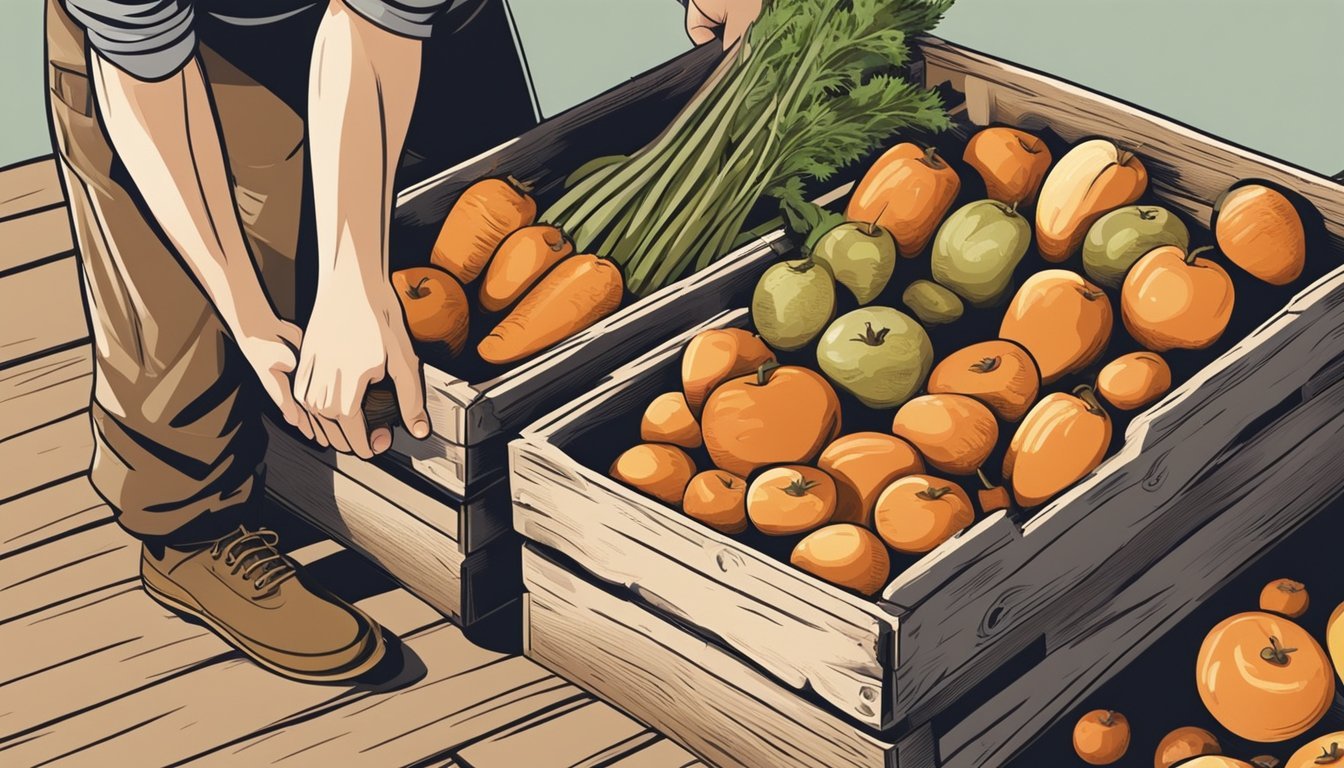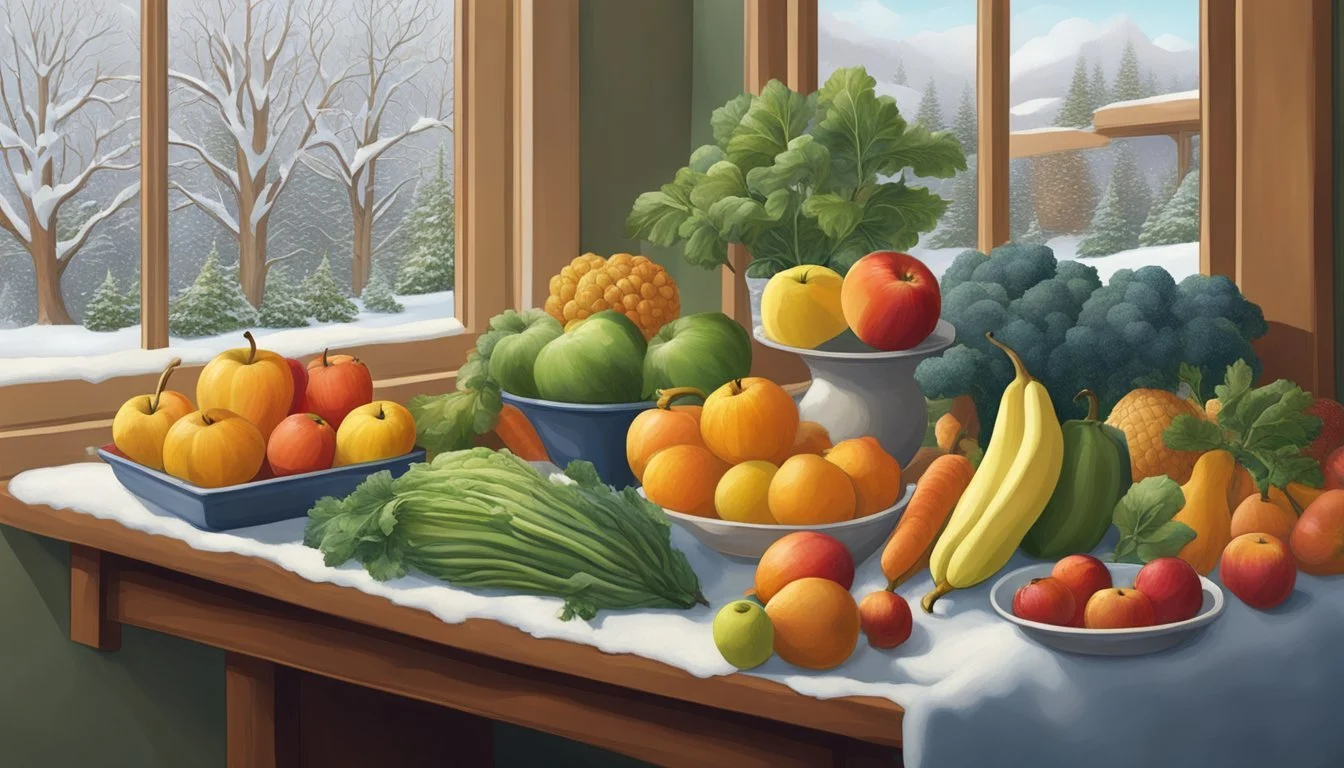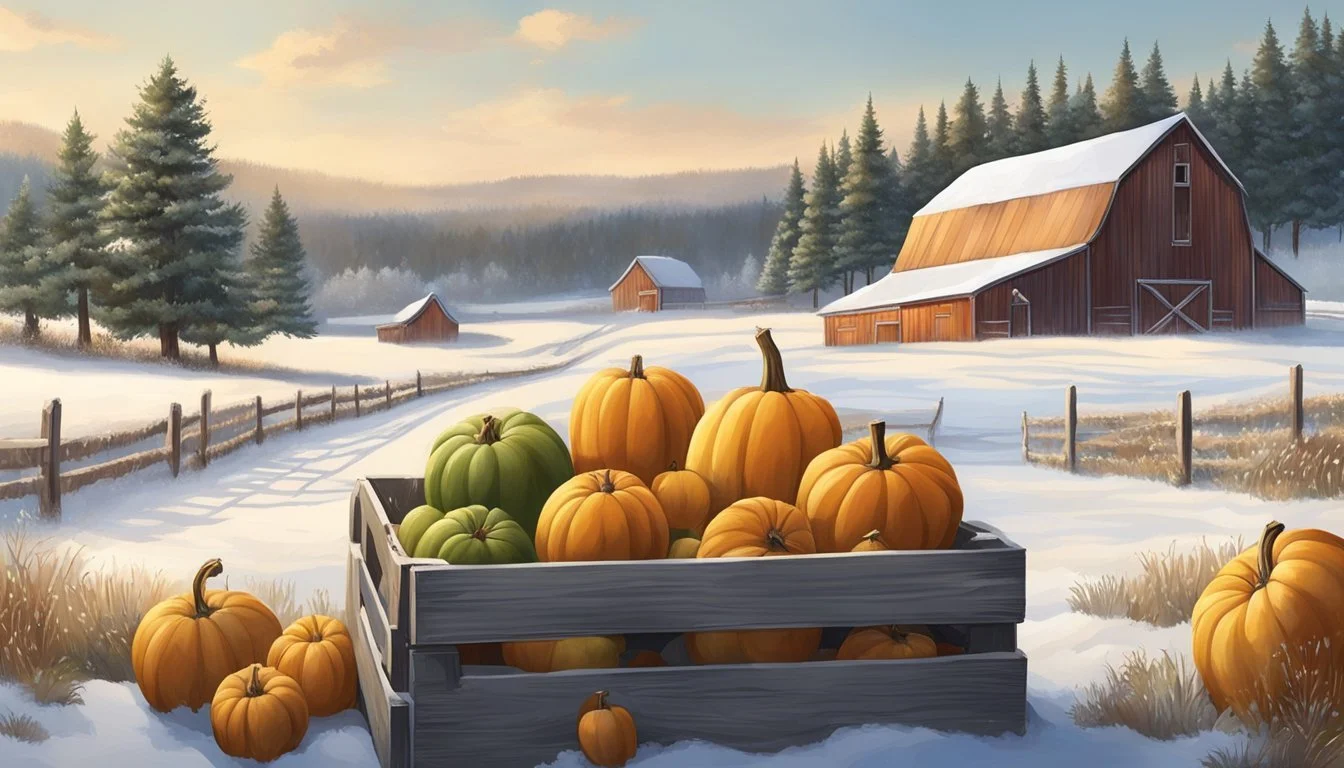South Dakota Seasonal Fruit & Vegetables in December
A Fresh Guide
This Article is Part of our South Dakota Seasonal Fruit & Veg Calendar
In South Dakota, December marks a time when the landscape is often blanketed in snow and the chill in the air signals the deep of winter. During this month, fresh local produce is less abundant than in the bountiful summer months. However, residents and chefs alike can still access a variety of seasonal fruits and vegetables that thrive in colder conditions or are available due to modern storage techniques.
Seasonal fruits are limited in South Dakota during December, but the state's markets may still offer items such as late-harvest apples (how long do apples last?) from local orchards, which have been preserved through careful storage. Vegetables, on the other hand, feature more prominently with cold-hardy varieties like kale and spinach, which can withstand the freezing temperatures. Root vegetables such as turnips, beets, and carrots, along with stored crops like potatoes and winter squashes, also make a regular appearance, offering both nutrition and flavor during the winter season.
These seasonal offerings are a testament to South Dakota's agricultural adaptability and the ingenuity of its farmers. Local produce markets and community-supported agriculture programs pivot to highlight these winter-ready crops, ensuring that even in the coldest months, the people of South Dakota have access to locally-grown, nutritious produce.
Overview of South Dakota's Climate and Agriculture
The climate of South Dakota exhibits considerable variability but generally falls within the continental climate zone. The state experiences four distinct seasons, with cold, dry winters and hot, semi-humid summers.
Winter: December in South Dakota is characterized by its winter conditions. Temperatures during this month can be harsh, often dropping well below freezing. Such frigid conditions are important for certain crops that require a period of dormancy.
Temperature: The average temperatures in winter can significantly impact the farming calendar, often dictating the types of fruits and vegetables that can be cultivated. Producers must carefully select species and varieties resilient to these cold extremes.
Hardiness Zones: South Dakota's hardiness zones vary from zone 3a in the northern regions to 5b in the southern parts of the state. This zonal classification guides farmers and gardeners in selecting the most appropriate crop varieties for local conditions.
Hardiness Zone Typical Winter Temperature Range 3a -40°F to -35°F 3b -35°F to -30°F 4a -30°F to -25°F 4b -25°F to -20°F 5a -20°F to -15°F 5b -15°F to -10°F
Agriculturally, these climate specifics influence the growing season's length and what crops are viable. Despite the challenging winters, a selection of fruits and vegetables still thrives in South Dakota. Root vegetables and hearty winter greens often do well, while farmers with greenhouses or other protective structures may extend their growing season to include a wider variety.
December Seasonal Produce in South Dakota
In December, South Dakota's harsh winter climate narrows the availability of fresh produce, yet certain hardy vegetables and fruits still thrive. Locally grown, they offer robust flavors and essential nutrients during the colder months.
Winter Vegetables and Greens
December in South Dakota marks a time when kale and Brussels sprouts (how long do brussels sprouts last?) remain in season, known for their resilience in cooler temperatures. These greens can bring a fresh, earthy flavor to seasonal dishes.
Kale: A nutrient-dense leafy green, excellent for salads, soups, and stews.
Brussels Sprouts: Offering a slightly nutty taste, ideal when roasted or sautéed.
Root Vegetables and Tubers
Root vegetables and tubers sustain well through South Dakota's winter, with their ability to be stored without losing much of their taste or nutritional value.
Carrots: Sweet and crunchy, versatile for both raw snacks and cooked meals.
Potatoes: A staple with a wide range of culinary uses, from baked to mashed.
Beets: Deeply colored, with a sweet and earthy flavor, great for roasting.
Sweet Potatoes: Packed with flavor and nutrients, suitable for baking and casseroles.
Turnips: Starchy and slightly spicy, they are often mashed or roasted.
Hardy Fruits and Citrus
Fruit options are more limited during this time, but certain varieties still persist.
Apples: Remain in storage from fall harvest, maintaining their crispness and tartness.
Cranberries: Often harvested right before winter, they bring a tart flavor to holiday dishes.
Pomegranates: With seeds that add a burst of sweet and tart, these are commonly available.
Citrus fruits: While not locally grown, citrus fruits like oranges are seasonally imported and available.
Each of these fruits and vegetables offers the opportunity to create nourishing and flavorful winter meals in South Dakota.
Selecting and Storing December Produce
In the midst of winter, South Dakota offers a limited but quality selection of in-season produce, such as carrots, cabbage, celery (how long does celery last?), onions, apples, and pears. The key to enjoying these fruits and vegetables is knowing how to select the best ones and store them properly.
Best Practices for Vegetable Storage
When selecting vegetables like carrots, cabbage, and celery, look for firmness and a lack of blemishes. Carrots should be bright orange, firm, and smooth. For cabbage, the heads should be dense and heavy for their size, indicating freshness. Celery must be rigid with crisp stalks and bright green leaves.
To store these vegetables:
Carrots: Keep them in the coolest part of the refrigerator. Place them in a plastic bag with holes to allow air circulation, which will maintain their crispness for up to a month.
Cabbage: Store cabbage in the refrigerator, wrapped in plastic wrap to retain moisture. It can last up to two weeks when stored properly.
Celery: Wrap celery in foil and place it in the vegetable crisper drawer of the refrigerator; it will stay crisp for several weeks.
Optimal Fruit Preservation Techniques
Apples and pears thrive in colder temperatures, making them perfect for South Dakota's December climate. When choosing apples, they should feel firm and be free from bruises. Pears should be a little soft at the stem end, signaling ripeness without being too mushy.
For storing these fruits:
Apples: Store them in a plastic bag in the refrigerator to slow down the ripening process. They can remain fresh for three to four weeks.
Pears: If they are slightly unripe, store them at room temperature to ripen. Once ripe, transfer them to the refrigerator. They can be kept for up to a week when chilled.
It is advisable to keep apples away from other foods as they emit ethylene gas, which can accelerate the ripening of other produce. Additionally, avoid washing fruits and vegetables until you are ready to use them, as moisture can promote decay.
Preparation Tips for Seasonal Produce
As winter settles in, residents of South Dakota can still enjoy a bounty of seasonal fruits and vegetables. Proper preparation can enhance their natural flavors and nutritional benefits. Below are techniques and dish ideas tailored for the colder months.
Cooking Techniques for Winter Vegetables
Steaming Broccoli: Steaming preserves the vibrant green color and nutrients of broccoli. Cut into florets and steam until tender crisp. A sprinkle of salt and a drizzle of olive oil can elevate its natural flavor.
Roasting Squash: Squash varieties, including butternut and acorn, develop a richer taste when roasted. Cut squash into cubes, toss with olive oil, salt, pepper, and a hint of ginger for warmth. Roast until golden and caramelized.
Sautéing Kale and Chard: Sautéing greens like kale and chard quickly wilts them while retaining a bit of crunch. Garlic and a dash of red pepper flakes (how long do red pepper flakes last?) can be added for an extra pop of flavor.
Ideas for Cold-Weather Fruit Dishes
Apple Desserts: Apples can be transformed into cozy desserts. Core and slice apples, then bake with cinnamon and nutmeg for a simple fruit compote. Alternatively, they can be used in pies or crisps, combining with cranberries for tartness.
Pomegranate Accents: Pomegranate seeds (how long do pomegranate seeds last?) provide bright bursts of flavor. They can be sprinkled over salads or mixed into yogurt, adding a refreshing contrast to heavier winter meals.
Cranberry Concoctions: Cranberries aren't just for sauce—try baking them into desserts or mashing them with a bit of orange zest for a tangy spread. Balanced with sweetness, cranberries can complement many winter dishes.
Health Benefits of Seasonal Eating
Engaging in seasonal eating, particularly in December in South Dakota, can significantly enrich one's diet with nutrient-rich produce. The colder months introduce a range of seasonal greens, which are not only fresh but also packed with vitamins and minerals.
Availability of such seasonal produce is at its peak, ensuring that individuals have access to the freshest fruits and vegetables. These food items have likely traveled shorter distances to get to the table, often translating to better taste and nutritional value.
Among the seasonal offerings, salad greens stand out as a versatile choice for nutritious meals. These greens can range from spinach to kale, each offering distinct health benefits:
Spinach: High in iron, magnesium, and vitamins A, C, and K.
Kale: Contains powerful antioxidants like quercetin and kaempferol.
Eating seasonally supports a diverse diet, as it encourages a rotation of different fruits and vegetables throughout the year. This variety can lead to a broader intake of essential nutrients, which may positively influence overall health.
Residents can enjoy these benefits by incorporating seasonal produce into their diets, creating warm and wholesome dishes that highlight the fresh flavors of the region. By doing so, they not only enhance their own health but also support local agriculture and the environment.
Gardening Considerations in South Dakota
When it comes to gardening in South Dakota, one must select appropriate vegetables for the season and understand the implications of the local climate, soil pH, and plant hardiness zones.
Choosing Vegetables to Grow in December
In December, gardeners in South Dakota should focus on selecting vegetables that can withstand the state's harsh winter conditions. Hardy vegetables that can endure the cold include:
Root vegetables: such as beets and carrots
Leafy greens: including kale and spinach
These selections are known to be low-maintenance and can tolerate frost, making them suitable for South Dakota's fall and winter.
Growing Season and Plant Hardiness
The growing season in South Dakota can be quite short, with the last frost dates in spring occurring as late as early May and first frosts in fall coming as soon as October. The state falls within hardiness zones 3 to 5, requiring gardeners to plan carefully. Key considerations include:
Soil pH typically ranges between 6.5 to 7.5, suitable for most vegetables but may require adjustment in certain areas.
Pest and disease management strategies should be tailored to the specific challenges of each season.
Season extension methods, such as using high tunnels or cold frames, can increase the variety and yield of vegetables grown.
Understanding these factors helps gardeners optimize their efforts for successful harvests year-round in South Dakota.
Shopping for Local Produce
When choosing produce in South Dakota during December, consumers benefit from understanding local market locations and seasonal availability to make informed purchases.
Finding Farmers Markets and Local Vendors
Farmers markets are a staple in South Dakota for accessing locally-grown fruits and vegetables. Shoppers can find their nearest market by consulting city websites or utilizing state-supported agricultural maps. Many cities operate indoor markets during winter months, ensuring year-round access to local goods.
Markets usually offer a diverse range of produce, but due to South Dakota's climate, the selection in December may be limited. It's recommended for consumers to check local market schedules and vendor lists, which are frequently updated on market websites or social media platforms.
Seasonal Produce Availability Calendar
A seasonal produce availability calendar is an essential tool for anyone looking to buy fresh, local fruits and vegetables in South Dakota. Such a calendar highlights which produce items are in season:
Vegetables in December may include:
Beets
Carrots
Potatoes
Fruits are generally scarce, but stored or greenhouse-grown produce might be available, such as:
Apples (stored)
High-tunnel tomatoes (limited)
Consumers should note that these items are subject to change based on specific regional climates within the state and the practices of individual producers. Calendars can typically be found on state agricultural websites (What wine goes well with kale?) or through local extension services.
Conclusion
In South Dakota, December marks a time of transition where seasonal produce availability shifts primarily towards storage crops and greenhouse-grown items. The state's robust agricultural practices enable residents to access a variety of fruits and vegetables, even as the winter chill sets in.
The local community benefits significantly from the consumption of these seasonal goods. They not only enjoy the fresh taste but also the associated health advantages. Plus, choosing local offerings supports South Dakota's economy and reduces the carbon footprint tied to long-haul transportation.
Here's a brief overview of what one can typically find in December:
Vegetables:
Root vegetables like beets and carrots
Hardy greens such as kale
Storage crops like potatoes and onions
Fruits:
Stored apples from the late fall harvest
While the variety may be less than in the summer months, these staples offer both versatility in the kitchen and nutritional benefits. The cool temperatures of the South Dakota winter necessitate a reliance on hearty produce capable of withstanding such conditions or being stored effectively.
Consumers are encouraged to visit local farmers markets or food co-ops to discover the array of available produce. One might also explore local preserves, jams, and pickled vegetables, which are popular methods to extend the life of the summer and fall bounty.
By embracing the seasonal rhythms, South Dakotans continue to foster a resilient and health-conscious community.







